For effective treatment of dermatitis century in modern medicine, various creams and ointments are used. The disease is accompanied by the development of an inflammatory process, redness of the skin, tissue swelling, and severe itching. In the absence of comprehensive treatment, patients may be worried about increased tearing, mucus from the eyes, and the development of conjunctivitis.
Infections and allergic reactions can provoke the appearance of eyelid dermatitis. The disease is accompanied by uncomfortable symptoms and can negatively affect visual acuity. Before using medications, the patient should consult with a qualified dermatologist who will determine the diagnosis and also prescribe an effective treatment regimen.
Record content:
-
1 Views
- 1.1 Seborrheic dermatitis
- 1.2 Eczematous dermatitis
- 1.3 Drug dermatitis
- 1.4 Allergic dermatitis
- 1.5 Atopic dermatitis
-
2 Stages and degrees
- 2.1 Acute stage
- 2.2 Chronic stage
- 3 Symptoms and Signs
- 4 Causes
- 5 Which doctor should I go to?
- 6 Diagnostics
-
7 Treatment methods
- 7.1 Ointments and creams
- 7.2 Traditional medicine recipes
- 8 Possible consequences and complications
- 9 Video about eyelid dermatitis
Views
Dermatitis of the eyelids (treatment, ointments and creams can only be prescribed by a dermatologist, since an incorrectly selected drug can provoke deterioration of the patient's well-being and the development of adverse reactions) can be of several types, each of which is characterized by a certain symptomatology.
Before purchasing drugs, the patient must undergo an examination so that the specialist can correctly determine the diagnosis and prescribe safe drug therapy.
Seborrheic dermatitis
The symptoms of this form of the disease can be easily confused with blepharitis. The edge of the eyelids is covered with multiple yellow crusts and small white scales.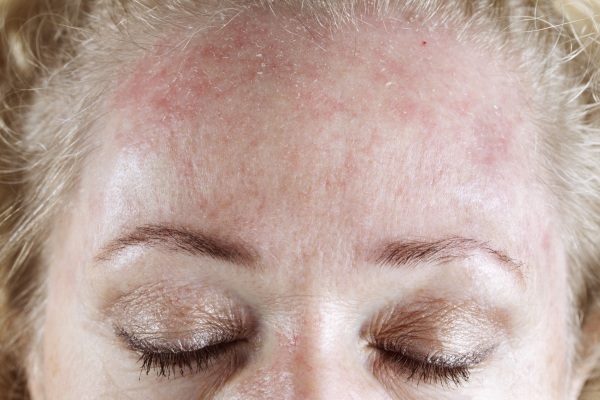
The skin becomes red, there is severe itching and burning. In the presence of seborrheic dermatitis, the patient is worried about increased dryness of the eyes, eyelashes may fall out. Ignoring the disease is fraught with a decrease in visual acuity, the development of an inflammatory process in the cornea of the eye.
Eczematous dermatitis
Eczematous dermatitis of the eyelids is diagnosed in isolated cases. This form of the disease is rapidly developing as a result of prolonged use of ophthalmic ointments with sulfonamide or antibiotics.
Eczematous dermatitis can provoke disturbances in the functioning of the organs of the gastrointestinal tract, as well as helminthic invasions present in the body. The disease is accompanied by hyperemia and swelling of the eyelids, numerous rashes appear on the skin. The epithelium becomes painful, itching and burning are present.
Drug dermatitis
The disease develops as a result of prolonged use of ophthalmic drugs in the form of ointments and drops. Pathology quickly turns into an acute form. Frequent use of eye drops causes an intensification of the inflammatory process in the area of the inner corner of the optic organ. Uncontrolled use of ointments provokes inflammation of the eyelids, conjunctiva.
Allergic dermatitis
Various decorative cosmetics (for example, shadows, carcasses), household chemicals, medicines, animal hair, pollen and insect bites can act as allergens. This form of the disease is characterized by severe hyperemia and swelling of the eyelids.
The discomfort is amplified several times as a result of mechanical scratching of the affected area of the skin. Allergic dermatitis is accompanied by severe itching and burning, tearing. As a result of a comprehensive examination, the patient may be diagnosed with conjunctivitis, rhinitis.
Atopic dermatitis
This form of the disease belongs to the category of chronic recurrent pathologies. The disease can provoke allergic reactions or infectious lesions of the epithelium of the eyelids. Pathology can also develop against the background of existing disturbances in the work of the gastrointestinal tract or due to damage to internal organs by helminthic invasions.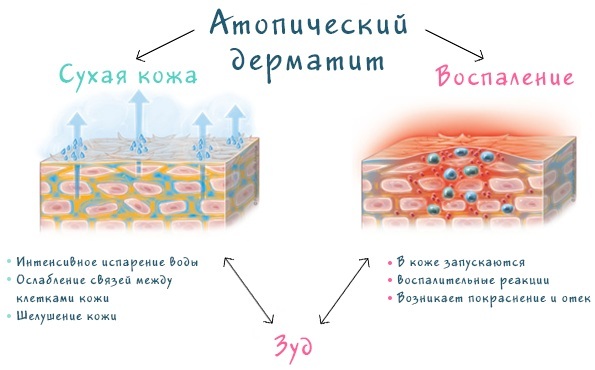
Atopic dermatitis is characterized by constant itching and burning of the skin of the eyelids. The epithelium can become covered with small vesicles that are filled with a clear liquid. In the absence of drug therapy, the disease will progress, which can significantly worsen the patient's quality of life.
Stages and degrees
Dermatitis of the eyelids (treatment, ointments and creams are recommended to be chosen depending on the form of the disease and the general condition patient) has several stages of development, each of which can negatively affect visual acuity the patient. Self-medication of dermatological pathologies can provoke a rapid progression of the disease and further deterioration of a person's well-being.
Acute stage
Dermatitis of the eyelids of the acute stage develops rapidly and gives the patient a lot of uncomfortable sensations, which is why drug treatment cannot be postponed.
Ointments and creams with bactericidal, immunostimulating, analgesic properties are very effective. In the absence of therapy, the area of the lesion will gradually increase, which is why the occurrence of concomitant pathologies is possible.
The acute stage of eyelid dermatitis is characterized by the following symptoms:
- Swelling of tissues.
- Hyperemia of the skin of the eyelids.
- Increased body temperature.
- Dry skin.
As the disease progresses, the patient may experience painful tingling in the eye, increased tearing. The swelling of the tissues may increase. For severe dermatitis, chills, aching headache, and malaise are characteristic. Treatment should be started immediately, since pathology negatively affects the functioning of the visual system.
Chronic stage
This form of dermatitis is characterized by rare relapses. The disease can bother the patient for several years, due to which the painful symptoms gradually intensify. A characteristic feature of the pathology is that it affects both eyes.
Pathology is manifested by the following symptoms:
- Redness of the skin around the eyes.
- Swelling of the eyelids.
- The development of conjunctivitis.
- Dry and flaky skin around the eyes.
- Thickening of the eyelids.
Dermatitis is not a life-threatening disease. But already at an early stage, this pathology can give the patient a lot of uncomfortable sensations, significantly worsening the quality of his life. For this reason, at the first manifestation of signs of eyelid dermatitis, you should seek the advice of a dermatologist.
Symptoms and Signs
Dermatitis of the eyelids (treatment, ointments and creams will only be effective if the patient adheres to the recommended the doctor of the treatment regimen) in 99% of cases is manifested by an increase in body temperature, chills, redness of the skin around eye.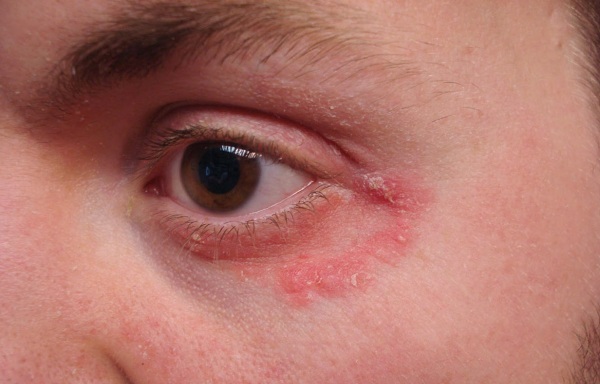
As a result of contact with the causative agent of the disease, the patient experiences the following symptoms:
- Profuse lachrymation.
- Pain in the eyes.
- Decreased visual acuity.
- The formation of multiple bubbles of liquid on the eyelids.
- Severe itching and burning of the skin.
- Loss of eyelashes.
In chronic dermatitis, pathology develops slowly, conjunctivitis may occur. The skin around the eyes gradually coarsens, cracks, flakes. The eyelids are covered with a rash. The disease affects both eyes, causing the patient to experience severe itching and burning of the eyelids.
If the inflammatory process was provoked by bacteria, then the crust on the papules acquires a characteristic yellowish tint. With mechanical combing of the skin, re-infection occurs, and abscesses form.
Causes
The skin around the eyes is highly sensitive, and besides, it is not protected from external irritants. For this reason, dermatological diseases can develop under the influence of allergens.
Laboratory studies have shown that the following factors can provoke the onset of eyelid dermatitis:
- Infection. Dermatitis of the eyelids can develop as a result of damage to the skin by a virus or a fungus that transmitted by contact with the carrier of the infection, as well as after the use of personal hygiene items by an outsider person.
- Disorders in the work of the organs of the gastrointestinal tract. Dysfunction of the gastrointestinal tract can provoke the occurrence of dermatological diseases.
-
Contact with allergens. Dermatitis can be provoked by low-quality cosmetic products, the use of medicines, and the frequent use of aggressive household chemicals. This category also includes seasonal allergies and the body's response to pet hair.

- Autoimmune diseases. Violations in the protein compounds of the cells of the body can provoke the development of atopic form of eyelid dermatitis.
Medical statistics confirm that dermatological diseases are increasingly being diagnosed in those patients who live in a region with poor ecology. If the patient has edema of the eyelid, then you should not try to eliminate it yourself. Before using medication, you need to undergo the necessary examination so that the doctor can determine the diagnosis.
Which doctor should I go to?
Dermatitis of the eyelids (treatment, ointments and creams will help get rid of the skin disease only if the patient refuses to cosmetics, and will clearly follow all the recommendations of the dermatologist) will not provoke the development of complications only if you promptly seek help from a qualified doctor.
Otherwise, the patient's condition will deteriorate rapidly. At the first suspicion of eyelid dermatitis, you need to contact a dermatological dispensary. After the initial examination, the doctor prescribes an examination for the patient and writes out a referral for consultation with narrow specialists.
For example:
- An allergist helps to exclude or confirm the presence of an allergic reaction to food, medications, animal hair or cosmetics in the patient.
- Consultation of an infectious disease specialist is needed if there is a suspicion of the rapid development of an infectious disease.
- The ophthalmologist examines the organs of vision.
- Contacting an immunologist will help you find out the exact immune status of the patient.
Only on the basis of the results of the examination of the patient, the dermatologist can correctly determine the diagnosis.
Diagnostics
To correctly determine the diagnosis, the dermatologist prescribes the necessary diagnostic procedures for the patient.
In 99% of all cases, the diagnosis of the disease consists of the following stages:
- The dermatologist examines the patient. This is often enough to correctly identify the disease. Collecting a detailed history helps the specialist to find out if the patient has a genetic predisposition to dermatitis. The doctor draws conclusions about the frequency of recurrence of pathology.
- The patient should undergo a general blood test for eosinophils.
- Based on the data obtained, the dermatologist excludes ophthalmological and dermatological pathologies. In each case, the set of laboratory tests is individual.
- Additionally, skin tests can be performed to find out which allergens are present in the patient's body.
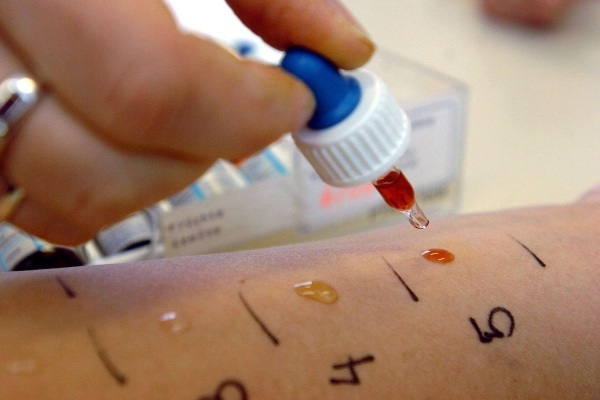
The enzyme-linked immunosorbent assay is very effective, thanks to which it is possible to determine the intensity of the development of the inflammatory process. PCR analysis helps to find out whether the viral load on the body is exceeded in the case when there is a suspicion of the infectious nature of eyelid dermatitis.
A special scraping of biomaterial for histological examination is carried out in order to confirm or deny the presence of seborrhea or any other fungal disease.
The results of the differential diagnosis of pathology are of great importance, since in dermatology there are a large number of diseases with similar symptoms. For example, erythroderma, toxicoderma, eczema. To combat these diseases, completely different treatment regimens are used.
In clinics in Moscow and St. Petersburg, PCR analysis costs from 260 to 680 rubles. For a general blood test, you will have to pay from 560 to 800 rubles. Skin tests for allergens cost from 120 to 450 rubles.
Treatment methods
To prescribe an effective treatment regimen for eyelid dermatitis, the doctor preliminarily determines the cause that triggered the development of the disease. With contact forms of pathology, it is necessary to block the action of the irritating substance. In 95% of cases, this is enough to overcome painful symptoms.
An important therapeutic measure is the abolition of allergenic cosmetics and medications, as well as the protection of the skin of the eyelids from the negative effects of the environment. Comprehensive treatment of dermatological diseases involves the use of medications, the use of traditional medicine recipes, the treatment of inflamed skin areas and adherence to a diet.
Ointments and creams
Inflamed areas of the skin of the eyelids can be treated with Solcoseryl or Fenistil gel. Antiseptic Wundehil perfectly disinfects the epithelium, heals existing microcracks. Dermatologists recommend choosing those ointments and creams for treatment that contain natural ingredients. Propolis, yarrow and sophora are very effective.
| Drug name | Description |
| Lipikar | This cream is indicated for the treatment of atopic dermatitis, restoring the natural protective barrier of the epidermis against negative impact of the environment, as well as with an individual patient's tendency to develop an allergic reactions. Contraindications include: pregnancy, lactation, intolerance to the components of a dermatological agent. To achieve a positive therapeutic effect, Lipikar cream must be applied to the eyelids once a day. The duration of treatment is determined by the dermatologist on an individual basis. |
| Sinaflan | This ointment is indicated for the fight against acute and chronic inflammatory pathologies of non-microbial etiology, which accompanied by increased dryness of the skin (neurodermatitis, dermatitis, psoriasis, sunburn, eczema of various genesis). The drug Sinaflan is forbidden to use for skin manifestations of syphilis, skin tuberculosis, as well as during pregnancy and lactation. This ointment is not prescribed for the treatment of children under 2 years of age. The drug is applied to the skin pretreated with an antiseptic agent 2-4 times a day. The duration of treatment depends on the form of the diagnosed disease. The maximum course of therapy is 25 days. |
| Diprolene | Indications for use: dermatitis, diffuse neurodermatitis, lichen, urticaria, eczema, discoid lupus erythematosus, generalized erythroderma. Diprolene is prohibited to use for melanoma, hemangioma, trophic ulcers of the leg, tuberculosis of the skin and hypersensitivity of the body to the components of the drug. The cream should be applied to the eyelids 2-6 times a day with an even thin layer. The duration of treatment is determined by the dermatologist. |
| Betamethasone | This drug is used by dermatologists to treat psoriasis, dermatitis, eczema, necrobiosis lipoidosis, and erythroderma. Betamethasone is contraindicated in the presence of the following diseases: varicose veins, acne, bacterial and viral skin lesions, plaque psoriasis. To achieve a positive therapeutic effect, the ointment is recommended to be applied to cleansed skin of the eyelids in the morning and in the evening. The standard course of treatment is 1-2 weeks.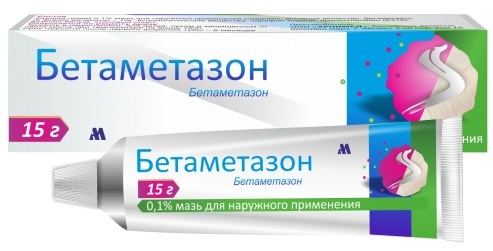
|
Before using the drug, you need to consult a dermatologist and study the annotation to the drug in order to exclude the possibility of contraindications.
Traditional medicine recipes
By combining traditional medications with traditional medicine, the final therapeutic effect of the combined treatment can be significantly increased. Time-tested recipes help to stop the inflammatory process, eliminate itching and burning, as well as overcome dryness and flaking of the skin.
For the treatment of eyelid dermatitis, the following recipes are most often used:
- Lotions based on chamomile decoction. To prepare a healing agent, you need to take 1 tbsp. l. chamomile flowers and pour 120 ml of hot water over them. The product must be brought to a boil and left on fire for another 5 minutes. The broth must be allowed to cool. The product should be filtered through a piece of gauze and used for lotions, rinsing the eyelids 3 times a day until complete recovery.
- Chamomile and string compress. For this recipe, you need to take dry string flowers and chamomile in a 1: 1 ratio. The components are mixed and filled with 200 ml of hot water for 5 minutes. After this time, the flowers of medicinal plants must be squeezed out and wrapped in a clean piece of gauze. It is recommended to apply the compress to the eyelids for 30 minutes. With regular use of this recipe, you can eliminate itching and burning of the skin of the eyelids, as well as overcome irritation and dryness of the epithelium, and stop the inflammatory process.
-
The use of tea tree oil. To combat eyelid dermatitis, you need to take 5 ml of refined sunflower oil and add 6 drops of tea tree oil to it. With the help of a cotton pad, the resulting product should be treated with an inflamed area of the skin in the morning, at lunchtime and in the evening for 1-2 months. This recipe is in high demand for its antiviral, anti-inflammatory and antibacterial properties.

Additionally, dermatologists recommend that patients follow the rules of personal hygiene, regularly perform wet cleaning living quarters, strengthening the body's immune system and undergoing a comprehensive examination 2 times a year organism.
Possible consequences and complications
To reduce the likelihood of progression of eyelid dermatitis, experts recommend abandoning the idea of hiding the affected areas of the skin with cosmetics.
Otherwise, re-infection may occur, which is difficult to overcome even with modern medications. In the absence of effective treatment for ocular dermatitis, the likelihood of developing serious complications increases significantly.
In such a situation, the occurrence of an inflammatory process in the area of the cornea of the eye is not excluded, which will contribute to a rapid decrease in visual acuity. At an early stage of development of eyelid dermatitis, correctly selected ointments and creams help to cope with the disease in 15-20 days.
Video about eyelid dermatitis
Doctor about eyelid dermatitis:



